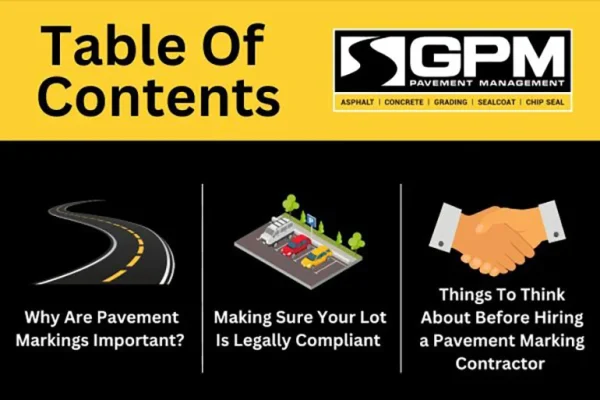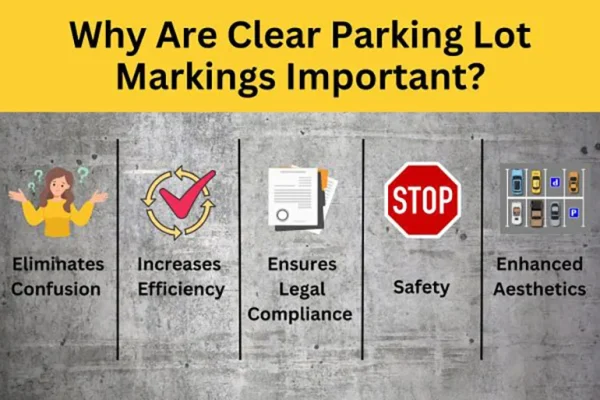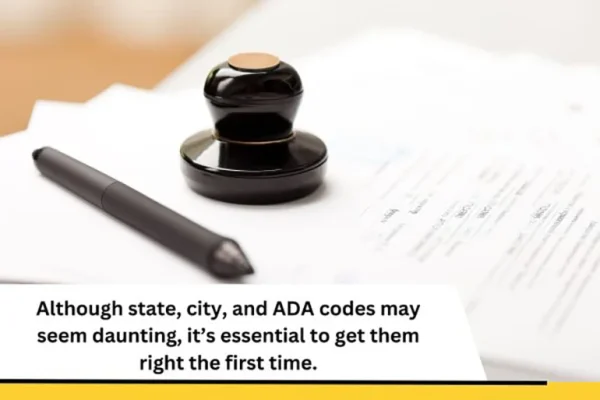As a property manager, you probably know how important it is to have a well-maintained parking lot.
After all, your parking lot is the very first thing customers experience at your business!
That is why General Pavement Management put together this guide to pavement marking for property managers. In this guide, you’ll learn why pavement markings are important, how to make sure your lot is up to local codes, and what to think about before you mark your pavement.

Why Are Pavement Markings Important?
Have you ever tried to navigate a confusing parking lot with faded or invisible markings?
It can be frustrating!
You may not know which way to go, and unexpected head-on encounters with other vehicles can cause sudden braking.
Finding a parking spot can be stressful, particularly in a busy lot.
You certainly wouldn’t want your customers to experience that at your business! However, clear pavement markings are critical for more than just one reason.
Here are a few points that summarize why having good, clear markings in your parking lot is important:
- Eliminate confusion – Without markings, customers can be confused, disoriented, and unsure of where to go.
- Increase efficiency – A well-marked lot enables traffic to flow smoothly, allowing people to navigate quickly and efficiently.
- Ensures you are legally compliant – Laws govern how parking lots should be set up. Failure to comply with these laws can result in fines, and property owners can be held liable for accidents that occur in their lots.
- Keep people safe – An unmarked or poorly marked parking lot is a safety hazard, and it’s important to prioritize the safety of your customers and employees.
- Enhance aesthetics– A pot-hole-ridden lot with fading markings doesn’t reflect well on your business. A cleanly striped lot makes your business’s exterior appear more professional and polished.
Clearly, a well-marked parking lot is important and beneficial to your business. But what exactly is included in a well-marked lot?
In the next section, we’ll get practical and find out what markings you should include in your lot to ensure it’s safe and legally compliant.

Making Sure Your Lot Is Legally Compliant
As a business owner, you want to be sure that all parts of your business are legal, including your parking lot.
You should pay special attention to two types of regulations when marking your lot: state and city regulations and ADA regulations.
State/City Regulations
Your state likely has parking lot standards somewhere in its building code, which may regulate factors such as parking space sizing, line color, and the number of parking spaces you must include in your lot based on the size of your business. It’s important to remember that these codes can vary from state to state.
In addition to state regulations, you may also be subject to city regulations, which are typically more strict and specific. These requirements may include what colors and symbols you should use, number of parking spaces, or other factors specific to your area.
All these regulations may seem like a lot of red tape, but remember that the point is to keep people safe and healthy, not to put you through unnecessary stress.
ADA Regulations
ADA stands for the Americans with Disabilities Act.
The ADA puts laws in place that ensure people with disabilities have equal access to businesses. Non-compliance with ADA laws can result in fines, and severe transgressions can even lead to the suspension of business operations.
ADA regulations can affect:
- The number of accessible parking spaces that must be marked in your lot. In general, one out of every 25 parking spaces you have must be marked as handicapped.
- The specific measurements of accessible parking spaces. Most regulations specify that each parking space must be at least nine feet wide and have an access area for wheelchairs.
- The location of accessible spaces. Normally handicapped spaces must be within the most direct route to the building, and there should be no blockages or stairs in the path to the entry.

- Although state, city, and ADA codes may seem daunting, it’s essential to get them right the first time. Otherwise, you may have to go back and make changes, which causes stress and costs time and money. Besides, it’s about more than just your business. Compliance is about showing genuine care and concern for the people who visit your property, not just generating revenue. The best way to ensure you get it done right is to hire a competent line striping contractor who is familiar with the local guidelines. They can help you plan your lot and save you the time and stress of learning about all the regulations.
Things To Think About Before Hiring a Pavement Marking Contractor
If you need to mark a new lot, or improve an existing one, your first step should be hiring a line striping contractor. Next, you’ll want to ask a few questions to make sure you are on the same page and following best practices.
Here are a few things to discuss with your contractor before you start pavement striping<:
Quality/type of paint
There are several different types of paint for pavement marking. The best one for your project depends on your location and specific needs.
Here are some of the available types of pavement paint:
- Water-based paint – This is the cheapest and most environmentally-friendly option. It also dries quickly but is not the most durable option on the market.
- Oil/solvent-based paint – This is the most commonly used option because it offers the best durability-to-cost ratio and does not freeze in cold weather like water-based paint.
- Thermoplastic paint – This paint contains plastics and is the most durable and expensive option. It is often used in high-traffic intersections and airports.
- Canned aerosol line striping paint – For someone looking to stripe and maintain their own parking lot, aerosol line striping paint and a simple line striping machine are good options.
Remember, different paints suit different needs. For example, thermoplastic paint may be best for a high-traffic inner-city intersection, but it may be too expensive for a small business parking lot.
On the other hand, if you are a small business owner without a large budget and want to minimize downtime as much as possible, inexpensive, quick-drying water-based paint could be your best option.
Your contractor should be able to make a wise paint decision for you based on your priorities, such as durability, maintenance, minimal downtime, and cost.

Special markings
Will you need any special markings? A special lane and waiting spot for delivery vehicles? Or spots for customers waiting on curbside pickup?
Note: line striping is normally charged by the foot, with extra charges for special markings such as arrows, letters, handicapped logos, etc.
Here is a list of approximate prices:
- 4-inch lines > $0.20 – $0.30 per linear foot
- 6-inch lines > $0.25 – $0.35 per linear foot
- 8-inch lines > $0.35 – $0.45 per linear foot
- 10-inch lines > $0.45 – $0.55 per linear foot
- 12-inch lines > $0.55 – $0.65 per linear foot
- Curb painting > $0.75 per linear foot
- Handicap logos (with background) > $25.00 each
- Handicap logos (no background) > $15.00 each
- Arrows – small > $10.00 each
- Arrows – medium > $20.00 each
- Arrows – large > $30.00 each
- Letters – small > $2.00 each
- Letters – medium > $2.00 each
- Letters – large > $2.00 each
Of course, pricing may vary between striping companies.
Bollards, car stops, and light pole bases
There may be additional items you need to include in your parking lot that fall under the category of line striping.
For example, safety bollards to create boundaries or car stops for your parking spaces. In addition, you may want to paint the bases of your light poles to create a clean, unified look in your parking lot design.

Use of reflectivity
You may want to consider some reflective tape or paint. If you have pole lights illuminating your space, then reflectivity may not be necessary, but it can be an added safety benefit.
If the people arriving at your place of business are likely to be hurried or flustered (for example, at hospitals and airports), then you’ll want to make your pavement striping extra clear and visible.
Downtime at your business
Depending on what type of business you run, minimizing downtime may be crucial. If this is the case, you can opt for quick-drying water-based paint or avoid disruption by striping your pavement at night.
Conclusion
As a property manager, you have a lot on your mind. We hope this article helps you to better understand pavement markings so you can keep your parking lot safe and well-maintained.
If you want more information on asphalt paving and parking lots, check out some of our other blogs:
Understanding the A-Z Of Sealcoating
6 Ideal Applications For Chip Sealing
If you want pavement marking services in Southern California or the Central Coast, give us a call here at General Pavement Management!
We would love to help you out with your a href=”https://gpmpavement.com/pavement-marking/”>pavement marking job, or offer you our other services:
Contact us today! We look forward to hearing from you.
